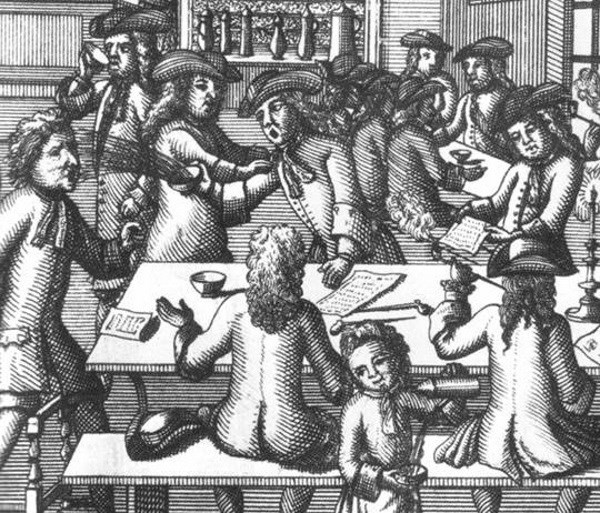
The Coffeehouse Mob (1710), British Museum
Students bring 17th century English coffeehouse to U of M
English course recreates Restoration period gathering place for all to enjoy
All are welcome to join Department of English, Theatre, Film & Media students on Feb. 11, 2019 to experience the social milieu of a Restoration coffeehouse, complete with skits, dramatic readings, informational and satirical pamphlets and FREE hot coffee and tea.
Monday, Feb. 11, 2019
1:30 p.m. – 3:30 p.m.
Room 627 Fletcher Argue Building
Student Alexa Watson shares how and why the pop-up coffeehouse will come to life as part of Literature of the Restoration and Eighteenth Century (ENGL 2120).
What was a Restoration coffeehouse and what was it like? Well I can tell you what it wasn’t; it wasn’t like your local haunt with dark earth-toned walls and everyone sitting quietly, plodding away at their own work. In fact, there really wasn’t much choice, there were giant communal tables, and you could choose between coffee, tea, chocolate and tobacco—that’s it. Oh, I forgot the lightly seditious and politically sensitive reading materials, which were provided free of charge.
Our English class—Literature of the Restoration and Eighteenth Century—was tasked with researching, planning and reenacting a Restoration coffeehouse. By bringing this historical phenomenon to life, we gain a more intimate knowledge into what they were. It’s natural to ask why you are learning about something and why it is important; by making this pop-up coffeehouse, we not only get to ask those questions but answer them ourselves. There are copious amounts of texts and documents that describe the coffeehouse, but just reading off of a page does not provide the multi-sensory, embodied experience that our re-creation will allow.
But why coffeehouses, you might ask? As Dr. Erin Keating, the professor spearheading this pop-up, explains it: “coffeehouses were integral to the rise of what we call the ‘public sphere.’” They were radical. At this time, most people hung out in alehouses or taverns. This was an era where everyone was segregated by status. But coffeehouses allowed anyone of any rank or economic status to mix; this is because they were completely open-seating, non-private, and dirt cheap. Only here could you find a lord and a servant sitting next to each other, as if they were equal. Do you remember the politically sensitive materials I mentioned earlier? Everyone had access to those too, and if you couldn’t read, someone would read them to you.
These spaces were controversial and extremely radical, but also, they were supremely popular. The first coffee house opened in 1652, by 1663 there were 82 across England and by 1700 there were approximately 1000—they exploded. Coffeehouses are an intrinsic element of English culture during the Restoration period (1660-1700); through hosting this pop-up, we get to experience our learning live. We have had to research and plan to ensure this experience is historically accurate. But coffeehouses were fascinating spaces, this learning project is also for the public’s pleasure and amusement. Our event will include skits, heated debates, and we will also be wandering around the arts complex to tell you the absolutely not inaccurate, completely true health-benefits of coffee. Whether you come by because you want to learn more about what a Restoration coffeehouse even is, or you simply want to see our crazy reenactment shenanigans, come on down, I promise you it won’t be a dry afternoon.







intriguing, I might have to investigate!